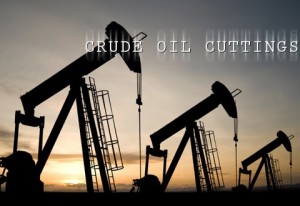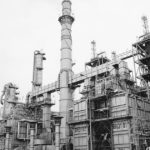 CRUDE OIL INVENTORY/’000 bbls (Week Ended 1/9/15)
CRUDE OIL INVENTORY/’000 bbls (Week Ended 1/9/15)
Current: 387,782
Actual Build/(Withdrawal): 5,389
Economist Average Estimate: 1,750
Previous: 382,393
Click here for the chart with five year averages.
Click here for an archive of EnerCom’s Inventory Reports.
ANALYST COMMENTARY
KLR Group
Demand
Demand of ~19.2 Mmbpd decreased ~0.6% w/w, and the four-week moving average decreased ~160 bps to ~4.9% higher y/y. Gasoline demand of ~8.9 Mmbpd was up ~0.7% w/w, and distillate demand increased ~37.6% to ~3.9 Mmbpd. In ’15, we expect U.S. demand to increase ~1% y/y to ~19.2 Mmbpd.
Inventories
Composite inventories increased ~11.5 Mmbbls, versus the consensus estimate of a ~7.9 Mmbbls build w/w. API reported a ~7 Mmbbls increase in composite inventories w/w. Crude oil supplies grew ~5.4 Mmbbls, while consensus expected a ~1.8 Mmbbls increase and API estimated a build of ~3.9 Mmbbls. Gasoline stocks increased ~3.2 Mmbbls versus the consensus estimate of a ~4 Mmbbls build w/w. API reported a build in gasoline stocks of ~2.7 Mmbbls w/w. Distillate inventories increased ~2.9 Mmbbls w/w, versus the consensus estimate of a ~2.1 Mmbbls build. API reported an increase in distillate stocks of approximately 0.4 Mmbbls.
Cushing stocks increased ~1.8 Mmbbls w/w to ~33.9 Mmbbls, while API reported a build of ~1.7 Mmbbls. Midwest stocks grew ~2.3 Mmbbls to ~111.6 Mmbbls (~93% of capacity). WTI has increased ~$0.07 after the report release and is currently up ~$0.36 today at ~$46.25.
Thesis (as of January 13, 2015)
We believe from Saudi’s perspective, the magnitude of the necessary supply reduction, largely attributable to robust growth in U.S. tight oil, rendered the role of swing producer less economic than maintaining output and allowing oil prices to fall meaningfully below equilibrium in the near-term.
We expect Brent/NYMEX $62.50/$57.50 oil prices this year and $85/$80 next year. In our view, the negative supply implication of lower global oil resource capitalization over the next two years, evident in the U.S., supports a long-term Brent/NYMEX oil price forecast of $100/$92.50. A long-term Brent/NYMEX $100/$92.50 oil price is sufficient to generate an industry norm ~5% return on invested capital.
Given the oil price forecast outlined above, Saudi Arabia’s volume strategy is economically accretive by 2H/18 versus a sustained ~15% output reduction. Clearly, Saudi believes the cost of oil supply is significantly higher outside the OPEC Gulf States.
CIBC World Markets
Today’s oil inventory report was bearish across the oil complex as the EIA showed significant builds across crude (+5.39 mb) and refined products (gasoline: +3.2 mb, distillate: +2.9 mb). Stocks at Cushing grew by a sizable 1.8 mb, which comes despite strong pipeline outflow from Cushing to the Gulf with volumes on the Seaway pipelines and Marketlink totaling over 970 kbd (which is the most that we’ve seen to date). The lateral pipeline connecting the ECHO storage terminal in Houston (which is fed by Seaway) to refineries in the Beaumont and Port Arthur area is currently undergoing linefill and will help to move Canadian barrels to a further range of refiners in the Gulf.
The drop in refinery runs contributed to the sizable crude stock build. Refinery utilization fell across most regions. Cold weather hindered some throughput last week, but planned maintenance is expected to ramp up over the coming weeks before peaking near 750 kbd during the last week of February. For the aggregate US, planned work is expected to be in line with seasonal norms next month, but taper significantly throughout March. Total planned maintenance for the total US is expected to average 575 kbd for the quarter. Refinery input costs are cheap, but shrinking margins and ample product supplies could result in growing crude stocks over the coming months (Q1 is typically a weak quarter for demand).
A surge in imports also factored into the large crude build. Imports surged by 636 kbd on the week, with shipments into the Gulf (+292 kbd) and West Coast (+480 kbd) making up the majority of the gain. The increase in imports from Ecuador explains the rise in imports in PADD 5, while the increase in shipments into the Gulf was a result of imports from Mexico rebounding in a big way (increasing by almost 430 kbd) following depressed levels last week resulting from weather related issues. Imports from Saudi also saw a 130 kbd uptick WoW, but outright volumes remain low (~700 kbd ) as the focus of the Saudis continues to be prioritizing market share in Asia over the US.
Important disclosures: The information provided herein is believed to be reliable; however, EnerCom, Inc. makes no representation or warranty as to its completeness or accuracy. EnerCom’s conclusions are based upon information gathered from sources deemed to be reliable. This note is not intended as an offer or solicitation for the purchase or sale of any security or financial instrument of any company mentioned in this note. This note was prepared for general circulation and does not provide investment recommendations specific to individual investors. All readers of the note must make their own investment decisions based upon their specific investment objectives and financial situation utilizing their own financial advisors as they deem necessary. Investors should consider a company’s entire financial and operational structure in making any investment decisions. Past performance of any company discussed in this note should not be taken as an indication or guarantee of future results. EnerCom is a multi-disciplined management consulting services firm that regularly intends to seek business, or currently may be undertaking business, with companies covered on Oil & Gas 360®, and thereby seeks to receive compensation from these companies for its services. In addition, EnerCom, or its principals or employees, may have an economic interest in any of these companies. As a result, readers of EnerCom’s Oil & Gas 360® should be aware that the firm may have a conflict of interest that could affect the objectivity of this note. The company or companies covered in this note did not review the note prior to publication. EnerCom, or its principals or employees, may have an economic interest in any of the companies covered in this report or on Oil & Gas 360®. As a result, readers of EnerCom’s reports or Oil & Gas 360® should be aware that the firm may have a conflict of interest that could affect the objectivity of this report.







